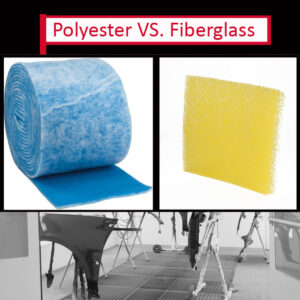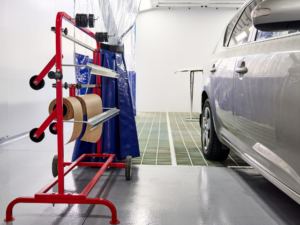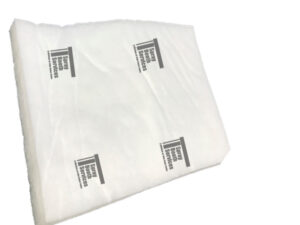
Edges of Polyester Filters to switch from fiberglass
Spray booth filters are critical in maintaining the air quality within industrial spray booths. These filters are designed to capture paint overspray particles and prevent them from being released into the surrounding environment. The efficient functioning of spray booth filters is crucial not only for complying with environmental regulations but also for ensuring the well-being of workers and preventing potential health hazards.
Brief Overview of Spray Booth Filters
Spray booth filters act as a barrier between the paint overspray particles and the clean air that should be released back into the atmosphere. They function by utilizing various filtration mechanisms, such as mechanical entrapment, electrostatic attraction, or diffusion.
These filters are typically made of different materials, each with its own set of advantages and disadvantages. One type of commonly used filter material is fiberglass.
Fiberglass filters have been widely employed in spray booths due to their high initial efficiency and relatively low cost compared to other options. They effectively capture large paint particles, preventing them from escaping into the environment.
switch from fiberglass to Polyester Spray Booth Filters
While fiberglass filters have been a popular choice for many years, recent advancements in filter technology have introduced superior alternatives. One such alternative that is gaining traction is polyester spray booth filters. switch from fiberglass to polyester offers compelling benefits that improve both performance and air quality in spray booths.
Understanding Fiberglass Spray Booth Filters
When it comes to trapping paint overspray particles, fiberglass spray booth filters have been widely used in the industry for their effectiveness. These filters are constructed with a dense mat of fine glass fibers that create a labyrinth-like structure, allowing them to capture and hold onto tiny airborne particles.
As the air laden with paint overspray passes through the filter, the fibers create an intricate network that mechanically traps and collects the particles. This mechanism depends on the interception and impact of particles as they collide with the irregular shapes of the fibers.
The Advantages of Fiberglass Filters
Fiberglass spray booth filters offer several advantages that have contributed to their popularity. One notable advantage is their high initial efficiency at capturing overspray particles.
The dense structure of fiberglass fibers allows these filters to achieve impressive filtration rates right from the start, ensuring cleaner air within the spray booth environment. Additionally, fiberglass filters are relatively affordable compared to other filtration materials, making them a cost-effective choice for businesses operating spray booths.
The Disadvantages of Fiberglass Filters
However, despite their initial efficiency and cost advantages, fiberglass spray booth filters also come with some significant disadvantages that need careful consideration. First and foremost is their limited holding capacity for trapped paint overspray particles.
Over time, as more and more paint accumulates on these filters, they become saturated quickly and require frequent replacements or cleaning. This not only results in higher maintenance costs but also increases downtime for businesses.
Furthermore, another drawback associated with fiberglass filters is potential health risks due to fiber shedding. The glass fibers used in these filters can break down over time into microscopic fragments that may become airborne if disturbed or during filter handling or disposal processes.
Inhaled glass fiber fragments can pose respiratory health hazards for both workers within the spray booth environment and anyone exposed to the released fibers. Therefore, it is essential to consider alternative filter materials that minimize such risks.
The Rise of Polyester Spray Booth Filters
Polyester as an alternative material for spray booth filters
In recent years, there has been a significant shift in the spray booth industry towards using polyester filters as an alternative to traditional fiberglass filters. Polyester, a synthetic material made from long-chain polymers, offers several distinct advantages that make it highly desirable for use in spray booth filtration systems.
Its introduction has revolutionized the way paint overspray is captured and filtered within these environments. Polyester filters are engineered specifically to capture and retain paint particles effectively, ensuring cleaner air quality and improved overall performance of the spray booth.
The superior features of polyester, such as increased holding capacity and filtration efficiency
One of the most significant advantages of polyester filters over their fiberglass counterparts is their superior holding capacity. Fiberglass filters tend to clog up quickly due to their limited capacity, often requiring frequent replacements which can be time-consuming and costly. In contrast, polyester filters have a significantly higher holding capacity, allowing them to retain a much larger volume of paint overspray before requiring replacement or maintenance.
This increased holding capacity translates into longer filter life and reduced downtime for filter changes. Polyester filters also boast enhanced filtration efficiency compared to fiberglass alternatives.
They feature a multi-tiere structure that captures micron-size particles while allowing airflow. High-quality materials and fast techniques enable polyester filters to trap even smaller paint particles before they are released into the environment.
The benefits of using polyester filters including improved air quality and reduced maintenance costs
Using polyester spray booth filters can lead to notable improvements in air quality within the painting environment. By effectively capturing paint overspray particles, these filters prevent them from contaminating not only the surrounding atmosphere but also the internal components of the spray booth.
This results in cleaner air for workers, reducing the risk of respiratory issues and ensuring a healthier work environment overall. Additionally, improved air quality can enhance the quality of painted finishes by minimizing potential defects caused by contaminated air entering the booth.
Moreover, polyester filters offer significant cost savings in terms of maintenance and replacement expenses. Due to their increased holding capacity and longer filter life, polyester filters require less frequent replacements compared to fiberglass filters.
This reduces downtime for filter changes and lowers ongoing maintenance costs associated with filter replacements. Furthermore, improved filtration efficiency means that less overspray reaches downstream equipment such as exhaust fans or ductwork, reducing potential blockages or damage to these components.
Polyester spray booth filters have emerged as a superior alternative to traditional fiberglass filters due to their increased holding capacity, enhanced filtration efficiency, improved air quality benefits, and reduced maintenance costs. By harnessing advanced materials and design principles, polyester filters offer a solution that not only ensures cleaner air within spray booths but also contributes to a more efficient and cost-effective painting process.
Comparing Fiberglass and Polyester Filters
Side-by-side comparison of key characteristics
When evaluating spray booth filters, it is crucial to consider several key characteristics that directly impact their performance. Firstly, filtration efficiency plays a vital role in capturing and retaining paint overspray particles.
Fiberglass filters typically have an initial efficiency ranging from 85% to 95%, depending on their design. On the other hand, polyester filters boast a higher initial efficiency, often exceeding 95%, due to their densely woven fibers.
Another critical aspect is dust holding capacity, which refers to the filter’s ability to accumulate and retain particles before replacement is necessary. Fiberglass filters tend to have limited holding capacity due to their loose fiber structure and low-density composition.
In contrast, polyester filters exhibit a greater dust holding capacity thanks to their tightly woven structure and higher density of fibers. Pressure drop represents the resistance that airflow encounters when passing through the filter media.
Excessive pressure drop can impede airflow within the spray booth system and ultimately reduce its overall performance. Studies have shown that polyester filters generally exhibit lower pressure drops compared to fiberglass filters under similar operating conditions.
Statistical data supporting performance differences
Numerous studies have compared the performance of fiberglass and polyester spray booth filters for paint overspray capture. These studies consistently indicate that polyester filters offer superior filtration performance when compared side by side with fiberglass counterparts.
For instance, a study conducted by the US Environmental Protection Agency examined filtration efficiency using standardized test methods for both types of filters. The results showed that polyester filters achieved much greater filtration.
This stark contrast in efficiency highlights the inherent advantages of polyester over fiberglass in capturing fine paint particles effectively.
The research revealed that polyester filters demonstrated a particulate-holding capacity nearly twice that of fiberglass filters. This finding underscores the superior longevity and lower maintenance requirements provided by polyester filters.
Real-life case studies and customer testimonials
Beyond statistical data, real-life case studies and customer testimonials further validate the advantages of switch from fiberglass to polyester spray booth filters. Many painting facilities have reported significant improvements in air quality, reduced filter change frequency, and overall cost savings after adopting polyester filters. One notable case study involved a large industrial painting facility that transitioned from using fiberglass to polyester filters.
Their paint booth environment experienced noticeable enhancements as the finer fibers of the polyester media efficiently captured even smaller particulates that previously eluded the coarser fiberglass material. The facility reported cleaner air, reduced instances of paint specks contaminating finished products, and improved worker satisfaction.
Customer testimonials also emphasize the positive impact of switching to polyester filters. A car manufacturing plant praised how their switch led to fewer interruptions due to filter changes, resulting in increased productivity and decreased downtime.
Additionally, they highlighted how superior filtration efficiency contributed to a cleaner work environment, leading to better paint finishes on their vehicles. Such real-life experiences and positive feedback reinforce the many advantages offered by polyester spray booth filters over traditional fiberglass options.
Addressing Health Concerns with Fiberglass Filters
Potential health risks associated with using fiberglass filters
Fiberglass spray booth filters have long been a popular choice due to their affordability and initial efficiency. However, it is crucial to address the potential health risks associated with these filters. Fiberglass fibers can easily shed into the air, which may lead to respiratory concerns. It’s important to be aware of this to ensure a safe environment.
When inhaled, these tiny fibers can cause irritation, coughing, and even lung damage over time. Additionally, fiberglass filters do not effectively trap fine particulate matter, allowing harmful pollutants to recirculate in the air.
How switching to polyester can help mitigate these risks by reducing fiber shedding and improving overall air quality
Polyester spray booth filters offer an effective solution for mitigating health concerns associated with fiberglass filters. In contrast to fiberglass, polyester fibers are closely woven together and show a lower tendency to shed into the environment, making them a more eco-friendly option!
This significantly reduces the risk of inhalation and ensures cleaner air within the spray booth environment. Moreover, polyester filters provide superior filtration efficiency by capturing smaller paint overspray particles effectively while retaining them within the filter media.
Cost Considerations
Analyze the long-term cost-effectiveness
While the initial cost of polyester spray booth filters may be higher than fiberglass filters, it is essential to analyze their long-term cost-effectiveness. Polyester filters have a significantly higher particulate-holding capacity, reducing the frequency of filter replacements and minimizing downtime during maintenance.
Moreover, their superior filtration efficiency ensures better air quality within the spray booth environment, leading to potential savings by preventing product contamination and rework. Considering health benefits and fiber shedding, polyester filters are a cost-effective long-term investment.
Conclusion
By understanding the potential health risks associated with fiberglass filters and recognizing the benefits of switching to polyester spray booth filters, it becomes clear that this transition is not only necessary but highly advantageous. Polyester filters address fiber shedding concerns while improving overall air quality within spray booths.
With a straightforward installation process and proven cost-effectiveness over time, polyester filters offer an optimal solution that safeguards both worker health and operational efficiency. Making this switch enables businesses to create a safer work environment while maintaining high standards of productivity and quality assurance.
Feel free to contact us with any questions you might have. It’s always our pleasure to serve you.

 The Importance of Changing Paint Booth Filters: When and Why to Replace Pre-Filters, Ceiling Intake Filters, and Exhaust Filters
The Importance of Changing Paint Booth Filters: When and Why to Replace Pre-Filters, Ceiling Intake Filters, and Exhaust Filters  Paint Booth Exhaust Filters
Paint Booth Exhaust Filters  Understanding Spray Booth Filters
Understanding Spray Booth Filters  How to Choose Spray Booth Supplies
How to Choose Spray Booth Supplies  Spray Booth Ceiling Intake Filters
Spray Booth Ceiling Intake Filters